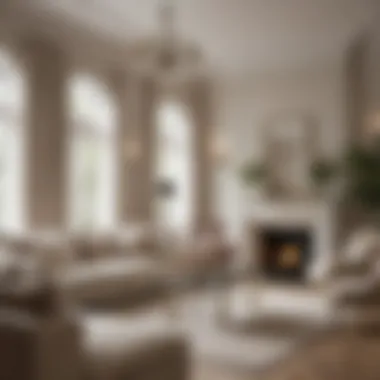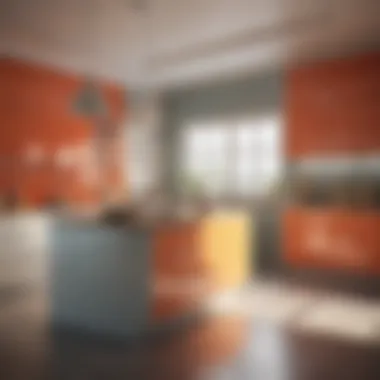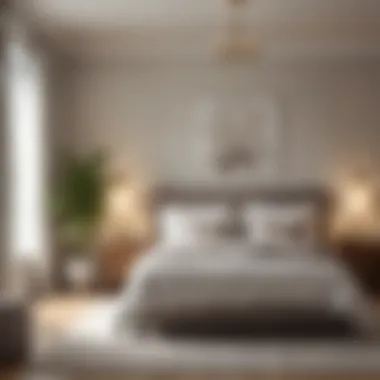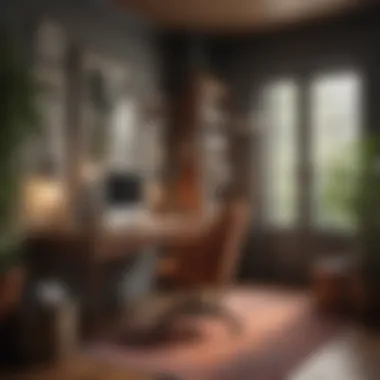Discovering the Best Paint Colors for Your Entire Home


Intro
Selecting the best paint colors for a whole house goes beyond a simple color palette. Homeowners must consider various factors, including mood, light, and personal style. This guide aims to offer an in-depth look into the complexities of color theory as it pertains to interior and exterior spaces. By understanding the optimal choices, homeowners can transform their properties into cohesive and inviting environments.
Outdoor Decor Ideas
Color choice for outdoor areas is crucial for creating a welcoming atmosphere. The exterior colors reflect not only personal style but also the context of the home itself. Here, we will explore different elements that shape outdoor design, enhancing your overall color choices.
Seasonal Inspirations
One of the most effective ways to choose outdoor colors is to take inspiration from the seasons. Spring may lean towards soft pastels, like pale greens and pinks. Summer often welcomes vibrant hues such as deep blues or warm terracottas. Autumn brings earthy tones, while winter usually favors muted grays or crisp whites. Consider how these seasonal changes can influence your color palette.
Furniture Selection
The furniture and decorative elements selected for outdoor spaces should harmonize with the chosen paint colors. For instance, if you opt for a rich navy blue wall, white or light-colored furniture can create a modern contrast. Equally, wooden furniture can add warmth, establishing a cozy feel. Therefore, selecting furniture that complements paint choices is essential for achieving balance.
Decorative Lighting
Lighting plays an important role in enhancing color. Consider using warm lights to illuminate neutrals and cool lights for vibrant colors. String lights, lanterns, and accent fixtures can transform the outdoor ambiance when paired thoughtfully with paint colors. Lighting should not only match the aesthetic but also work well during evening gatherings.
Plant Arrangements
Plants can add complexity and layers to your selected color scheme. For instance, pairing light-colored walls with darker greens brings depth. Additionally, colorful flowers can highlight neutral backgrounds. Always be mindful of how colors interact, enhancing the overall appeal of your outdoor space.
Hardscaping Solutions
Walkways, patios, and other hardscape elements contribute to the overall visual impact. Consider materials that complement your paint colors. For instance, natural stone can harmonize well with earthy tones while offering durability. Choosing the right hardscaping solutions is imperative for achieving a consistent style throughout your home.
Sustainable Practices
In today's world, sustainable practices are essential. Use paint brands that offer low-VOC options and eco-friendly materials. Combine sustainable choices with your color palette, promoting not just beauty, but also responsibility. A conscious approach to painting impacts both aesthetic outcome and the environment positively.
The color choices you make ultimately create an ambiance that reflects your values and lifestyle. Sustainability can be a part of elegance and design.
In sum, understanding how outdoor decor interacts with paint colors allows homeowners to curate a complex and inviting environment. Focusing on elements like seasonal trends, furniture selection, and lighting ensures that your home becomes a reflection of both personal taste and sophisticated design.
Closure
By recognizing the interconnectedness of color, light, and design furniture, homeowners will be better equipped to select paint colors that resonate throughout their entire house. Combining aesthetics with practical choices leads to a sanctuary that reflects individual style while being grounded in functionality.
The Significance of Choosing the Right Colors
Choosing the right colors for a whole house carries significant weight, acting as a foundational element in interior design. The colors selected do more than just beautify spaces; they shape how individuals perceive and experience their environment. In the home, color affects mood, sets tone, and influences functionality. Homeowners should consider the impact of hues not only on aesthetics but also on psychology and emotions.
Incorporating thoughtful color choices can elevate a living space, making it feel inviting, relaxing, or energetic, depending on the desired effect. Color selection is a reflection of personal style and can even enhance property value. For individuals considering renovations or new builds, this makes understanding color strategies essential.
Key Benefits of Choosing Colors Wisely:
- Enhances mood and emotions
- Creates spatial definition and flow
- Aligns with personal and lifestyle preferences
Choosing the right colors takes time and consideration, but the end results can truly transform a house into a home.
Psychological Impact of Colors
Colors possess inherent psychological meanings that can vary across cultures and personal experiences. For example, the color blue typically evokes feelings of calmness and serenity, making it an excellent choice for bedrooms or relaxation spaces. On the contrary, bright shades of red can create an energetic feel, ideal for social areas like kitchens or dining rooms.


It’s essential for homeowners to contemplate what they want each space to convey. A thoughtful study of color psychology aids in crafting harmonious environments. For further exploration, consider experimenting with samples to gauge emotional responses.
Some insights into color psychology include:
- Blue: Calming and tranquil.
- Yellow: Uplifting and energizing.
- Green: Balanced and restorative.
A color study can lead to impactful decisions and ensure the home reflects its inhabitants' desires and lifestyles.
Color Harmony and Cohesion
The principle of color harmony is fundamental to creating a cohesive look throughout a home. Harmony involves selecting colors that complement and enhance each other. It establishes a visual rhythm and balance that creates a sense of unity amongst spaces.
When attempting to achieve color harmony, homeowners might employ various techniques such as the color wheel, which illustrates relationships between colors. For instance, analogous colors sit next to each other on the wheel, creating a serene palette, while complementary colors attract attention by contrasting sharply yet elegantly.
Here are some methods to achieve color cohesion:
- Establish a color palette: Pick a primary color, secondary colors, and accents.
- Use 60-30-10 rule: Allocate 60% to dominant colors, 30% to secondary, and 10% to accents.
- Maintain consistency in finishes: Ensure that finishes and textures complement the chosen colors.
Implementing such strategies helps maintain coherence across living areas, allowing for a seamless visual flow while respecting the individuality of each space.
Understanding Color Theory
Understanding color theory is crucial when selecting the best paint colors for your entire house. This knowledge provides a framework to make informed decisions and creates cohesive aesthetics throughout the space. Color theory encompasses various elements, including primary, secondary, and tertiary colors, along with the distinctions between warm and cool colors. Each aspect impacts not only the visual appeal but also the overall atmosphere and mood of each room.
Primary, Secondary, and Tertiary Colors
Primary colors are the foundation of the color wheel. Red, blue, and yellow are the three colors that cannot be made by mixing other colors. They play a vital role in creating secondary colors, which are achieved by combining two primary colors. For example, mixing red and yellow gives you orange, blue and yellow create green, and red combined with blue results in purple.
Tertiary colors, created by mixing a primary color with a secondary color, add a more complex dimension to color palettes. Examples include colors like blue-green or red-orange. Understanding these relationships helps homeowners create balanced and harmonious schemes that resonate throughout the home.
Warm vs.
Cool Colors
Warm colors, such as reds, yellows, and oranges, evoke feelings of warmth and comfort. They can stimulate energy and activity, making them excellent choices for social spaces like living rooms or kitchens. On the other hand, cool colors like blues, greens, and purples promote a sense of tranquility and calmness. These colors are often ideal for personal spaces such as bedrooms or bathrooms.
It is important to consider the intended use of each space when choosing colors. For example:
- Living areas may benefit from warm colors to encourage conversation and socialization.
- Bedrooms could choose cool colors to relax and promote better sleep.
By mastering the principles of warm and cool colors, homeowners can strategically influence the mood and functionality of each room in their house.
Popular Color Trends for Whole House Painting
Choosing the right colors for your entire house demands careful consideration of both style and functionality. Popular color trends help in setting a tone that resonates with current aesthetics while also ensuring timeless appeal. An understanding of these trends allows homeowners to make informed decisions, blending personal taste with broader design principles.
Selecting trending colors can offer several benefits. First, they often reflect a sense of contemporary lifestyle, providing an updated look that can enhance the perceived value of a property. Additionally, current trends often prioritize versatility, meaning that these colors can adapt well to various design elements and furniture choices. Lastly, by staying aware of popular trends, homeowners can avoid choices that may lead to quick obsolescence.
Neutrals: Timeless Choices
Neutrals dominate the landscape of home design, providing a foundational color palette that complements various styles. Shades such as whites, grays, and beiges excite much interest, owing to their remarkable adaptability. Neutrals create a canvas that allows for personal decoration and seasonal changes without the need for a complete repaint.
A well-chosen neutral can have an expansive influence on the overall feel of a space. For instance, a warm beige can create an inviting atmosphere, especially in common areas like the living room or hallway. On the other hand, cool greys can project a sense of modernity and elegance, fitting perfectly in spaces that require a sophisticated touch, like an office or formal dining room.
Homeowners should also consider how neutrals interact with natural light. Additional attention to finishes, such as matte versus gloss, can further affect how these colors appear during different times of the day.


Bold Colors: When to Use Them
Bold colors represent a strategic opportunity to inject personality into your space. While they are not always suitable for every wall in the house, their application can create striking focal points. Colors like royal blue, emerald green, and deep burgundy can work wonders in limited areas or specific rooms such as the dining room or a shared space like a hallway.
When employing bold colors, it is crucial to balance them with calmer tones. This creates a dynamic contrast that engages the eye without feeling overwhelming. For instance, a deep navy accent wall paired with soft white furniture can result in visually appealing harmony.
Furthermore, consider how bold colors can reflect personal interests and themes, perhaps through an art collection or decorative elements. This makes the application of bold colors a very personal endeavor.
Pastels and Soft Hues
In recent years, pastels and soft hues have surged in popularity, enchanting homeowners with their gentle vibes. Colors such as blush pink, mint green, and pale lavender can transform spaces into serene retreats. These colors often promote relaxation and can be ideal for bedrooms and bathrooms.
Pastels allow for a sense of spaciousness and light, making them a suitable choice for smaller areas or those lacking natural light. By using soft hues, one can achieve a calming environment that feels airy and open.
Another advantage of soft colors is their versatility in pairing with decor. They can adapt to both traditional and contemporary furnishings, allowing for easy updates over time.
In essence, whether selecting neutral palettes, bold statements, or delicate pastels, understanding popular trends in color selection plays a crucial role in creating a cohesive and inviting home experience.
The Role of Natural Light
Natural light plays a crucial role in the overall impact of paint colors within a home. It influences not only how colors are perceived but also how they affect the ambiance of a space. Understanding this relationship can aid homeowners in making well-informed choices when selecting paint colors. Natural light varies throughout the day, affected by geographic location, season, and the orientation of windows. Acknowledging these factors helps to highlight the benefits and considerations when integrating natural light into your design choices.
Understanding Light Sources
When discussing natural light, it is essential to recognize the various sources that affect illumination in a home. Daylight comes primarily from the sun, but the way it enters a space can vary significantly based on several elements:
- Window Orientation: South-facing windows typically receive direct sunlight for most of the day, while north-facing windows may bring in cooler shadows.
- Time of Day: Morning sunlight has a different quality compared to afternoon light. Morning light tends to be soft and warm, whereas evening light can be more golden and vibrant.
- Seasonal Changes: The angle of the sun changes with the seasons, impacting the intensity and color of natural light that enters the home.
Understanding these light sources allows one to appreciate how they interact with paint colors, fundamentally altering the perception and mood of a room.
Color Perception in Different Lighting
The perception of color can shift dramatically depending on the quality of light in a space. Knowledge of this phenomenon is vital for homeowners aiming for a cohesive look throughout the house. Here are factors to consider:
- Color Temperature: The warmness or coolness of light affects how paint colors appear. Cooler lights can make warm colors look intense, while warmer lights can soften cooler colors.
- Intensity: High-quality, bright daylight can enhance the vibrancy of paint colors, making them appear more vivid. In contrast, dim lighting can mute colors, making them look more subdued.
- Reflective Surfaces: Glossy paints will reflect more light, affecting how colors are seen in relation to different light sources. This aspect must be considered when selecting finishes for walls or trim.
The interaction of color and light is complex, yet it crucially shapes the aesthetic and emotional experience of a home.
By being mindful of the impact of natural light on color perception, homeowners can choose paint colors that harmonize beautifully with their environment.
Choosing Paint for Different Spaces
Choosing paint colors for different spaces within a home is crucial. Each area has a unique function and atmosphere that can be enhanced by the right color selection. Room characteristics, lighting, and furniture should guide your choices to achieve the desired ambience. Utilizing specific colors suitable for each space fosters a harmonious flow and strengthens the overall design. It promotes comfort, invites relaxation, and can even augment productivity in home offices. The implications of these choices are far-reaching, influencing both the functionality and the emotional resonance of your living environment.
Living Areas: Creating Inviting Ambience
Living areas are often the heart of the home, serving as spaces for relaxation and socialization. The paint color in this setting should evoke warmth and comfort. Soft neutrals like beige, taupe, and soft gray can set a welcoming tone while allowing flexibility in decor. On the other hand, deeper tones such as navy blue or forest green may convey sophistication and depth but can darken a space. It's essential to consider natural light when selecting these hues, as they will appear differently throughout the day.
Kitchens: Practical Yet Stylish Options
In kitchens, practicality meets style. This area requires colors that prioritize cleanliness while maintaining aesthetic appeal. Light colors, such as white or light pastel shades, enhance brightness and make the space look larger. Using bold colors such as rich red or deep blue can create a striking focal point, lending an energetic vibe. The finish is also worth noting; semi-gloss or satin finishes allow for easy cleaning and durability against spills and splatters.
Bedrooms: Finding Serenity Through Color
Bedrooms should evoke a sense of tranquility and relaxation. Soft, muted colors like lavender, light blues, and earthy greens can create a calming atmosphere conducive to rest. These hues should be chosen with consideration of the individual's preferences and the overall decor. Darker shades may also work if used thoughtfully; a deep charcoal or navy can create a cocooning effect but should be balanced with adequate lighting.


Bathrooms: Balancing Hygiene and Aesthetics
In bathrooms, achieving a balance between hygiene and aesthetics is key. Light colors tend to make spaces look cleaner and more expansive. Popular choices include soft whites or cool blues. Incorporating darker tones can also work, but these should be combined with vibrant accents for contrast and warmth. The finish is vital in this context; selecting a semi-gloss or high-gloss paint aids in moisture control while offering a polished appearance. This balance will ensure that the space is both functional and visually appealing.
The paint color chosen for each room enhances both the mood and the function of the space.
Practical Considerations for Painting
When embarking on the journey of selecting paint colors for your entire house, certain practical considerations must be taken into account. These factors not only guide the aesthetic choices but also affect the durability and functionality of the spaces within your home. Knowing how to navigate these aspects will help ensure a successful outcome.
Effective planning is imperative. It involves considering the different paint finishes available, the preparation work needed before paint application, and the importance of testing colors in real-life settings. As a discerning homeowner or designer, understanding these elements allows for a more informed and confident choice when it comes to paint colors.
Finishes and Their Effects
The paint finish chosen for a space significantly impacts the final look and feel. Different finishes reflect light differently, possess varying levels of durability, and have distinct practical uses. Here are the most common options:
- Matte: This finish absorbs light, offering a smooth, non-reflective surface that disguises imperfections but is less washable. Best suited for low-traffic areas like bedrooms.
- Eggshell: A bit more durable, eggshell finish has a slight sheen that makes surfaces easier to clean. Ideal for living rooms and dining areas.
- Satin: This finish has a subtle glow and is very washable, making it suitable for high-traffic areas, such as hallways and kitchens.
- Semi-gloss: Excellent for moldings and trim, semi-gloss finishes reflect more light, providing durability and facilitating easy cleaning.
- High-gloss: Highly reflective, this finish is great for modern looks, creating dramatic effects but can highlight imperfections in surfaces.
Careful selection of these finishes helps incorporate functionality with style, which is critical in high-end interior designs.
Prep Work and Importance of Samples
Proper preparation cannot be overstated. Without it, even the most beautiful paint colors can turn disappointing due to improper application or surface issues. Start by cleaning the surfaces and ensuring they are dry and smooth. Repair any visible damages. A well-prepared space enhances the longevity and appearance of the paint.
Moreover, sampling is an essential step in the process. Applying swatches on the walls helps visualize how colors interact with light and existing furnishings. Consider the following:
- Obtain small paint samples of your top color choices.
- Apply patches in various lighting conditions during the day and evening.
- Observe how the colors change throughout the day.
Sampling prevents costly mistakes. Often, a color that looks ideal in a can may not translate well onto walls. Taking the time to test before fully committing can save money and disappointment.
Future Trends in Home Color Schemes
The choice of paint colors in home design is evolving continuously. Understanding future trends in home color schemes is essential for a sophisticated approach to interior design. Paint color choices reflect current societal values and preferences, influencing how spaces are experienced.
Sustainable and Eco-friendly Choices
Sustainability has become a focal point in various industries, and interior design is no exception. Homeowners are increasingly prioritizing eco-friendly paint options. These paints typically have low volatile organic compounds (VOCs), which are harmful pollutants. By choosing sustainable paints, homeowners contribute positively to the environment.
Benefits of eco-friendly paints include:
- Improved Indoor Air Quality: Low VOC paints reduce air pollution indoors, creating a healthier living space.
- Durability and Longevity: These paints may offer better resistance to fading, ensuring the colors last longer without needing frequent touch-ups.
- Aesthetic Variety: The market offers a range of colors and finishes, allowing homeowners to achieve desired looks while being environmentally conscious.
The trend toward sustainability reflects a broader commitment to a healthier lifestyle and environment. Homeowners should research available options, like companies that specialize in green products.
Integration of Technology in Color Selection
Technology also plays a pivotal role in contemporary design choices. Digital tools and apps help homeowners to visualize their spaces before actual painting. Tools allow users to experiment with a variety of paint colors and combinations. This can lead to more informed and confident decisions.
Technology offers several advantages in the paint selection process:
- Color Matching Tools: These programs can match colors to existing furniture or decor, ensuring consistency and harmony throughout the space.
- Virtual Reality (VR) Apps: Some applications even provide VR experiences to immerse users in their redesigned spaces.
- User Feedback: Online resources allow homeowners to view reviews and suggestions from others who have used specific colors and products. This peer feedback often guides decision-making.
Using technology not only simplifies the process but also enhances creative possibilities, making it easier to experiment with new ideas.
By staying abreast of sustainable practices and technology, homeowners can make informed decisions that honor both style and environmental stewardship.
Closure: Making Informed Choices
Choosing the right paint colors for your home is an essential segment of interior design. It is not merely about selecting shades that are aesthetically pleasing. It involves understanding your personal style, the psychological effects colors can impose, and how these colors will function harmoniously across different spaces. The decisions you make will encapsulate your home’s ambiance and character.
Reflecting on your personal style and preferences is paramount. The colors you select should resonate with your personality and lifestyle. They should contribute positively to your everyday experience within your home. If you favor serenity, you might opt for soft, neutral tones that cultivate calmness. Alternatively, bold colors could infuse your spaces with energy, perhaps aligning with a dynamic and active lifestyle.
Moreover,







